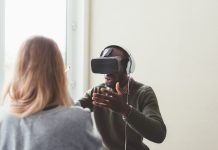
New means of transportation, conducting business, and information sharing have changed how we live and work. We are no longer confined to a small circle of our own neighborhoods and villages, for our jobs or personal networks. Thanks to air travel, cars, and developed transportation systems and infrastructure, we can go as far as we want with relative speed. And this extent of our reach continues to grow. Connection and opportunity are as close as our fingertips to a universe full of possibility.
Navigating the digital era
So how do we navigate this brave new world? How do we engender functional trust that helps us live and work? Our barrier to operating seamlessly lies in how we trust each other as we share and exchange information about our lives, our credentials, our contributions. And as we work together across geographical boundaries, the next revolution is in trusting each other in our connectivity.
And trust is then the biggest need and enabler to work together across the world. Now, even as you read this, three rapidly evolving developments are in influence. Fueled and driven by technology, they snowball and entangle as they unfold. They will change how we live, work. And trust.
The rise of quantum computing
First, the rise of Quantum Computing with its impact on data processing and encryption. Second, the speed of Space Exploration with its implications on industry, geopolitics, security and, very remote work. Third, the origami horizons of the Metaverse. Each of these developments accelerates and alters our ability to connect. All magnify the need for real trust.
Our digital identity is increasingly critical to how we engage with all the transactions and processes of everyday life. The pandemic highlighted the need for valid digital identity as work and related activities became increasingly remote. New York City deployed the Excelsior Health Pass which tracked vaccination information, using blockchain. Some countries are starting to use blockchain to validate identity in elections. Poland and Georgia (and some counties in the US), are using blockchain technology in order to bring security and transparency to land registration, while in the UK blockchain as a service (BaaS) facilitates student loans and welfare checks, and retirees get paid using mobile applications using blockchain.
Think of all the people on our planet, about 7.9 billion, expected to reach 8 billion in 2023. That really is our talent ecosystem, because each of those 7.9 billion is a person who has skills to contribute in some way. Now, the truth is that only about 60 percent of the world’s population are formally employed. But many others make their living in the informal economy. And that’s why blockchain is so important and helpful because blockchain can provide a way for us to actually tap into this entire population of skills, both formal and informal. It has the ability to identify, validate, and provide a platform for people of different skills in different locations to engage and participate in work. Employers broaden their pool of talent to find more of the skills they need, and steady, stable employment becomes more accessible.
The untapped talent pool
How vast is that untapped talent pool? In Africa, about 86 percent of employment is informal; in Asia, it’s 68 percent. Right there, those are millions of people left out of the equation, partially because of education, partially because they don’t have access to formal sector jobs. So if the people in sub-Saharan Africa who may be foraging right now, living in poverty, were given the training to code—if they were able to write code, if they were able to participate—how much more effective would we be as a global community?
Those of us who hold managerial or executive roles understand the importance of bringing the right people onto the team. We know the frustrations and challenges of recruiting and retaining talent in an increasingly dynamic business climate. We know how difficult it is to find the right person with the right skills and to help them grow and develop.
Additionally, with the continuous business disruption we see these days, the skills required to pivot with strategy are constantly changing. Organizations increasingly recognize that you can’t let go of employees and rehire each time for new skills. Instead, you have to reskill, upskill, and tap into the ecosystem of talent that is available on-demand. It’s no longer about hiring and developing people; it’s about tapping into the entire talent ecosystem, inside and outside the organization.
The pandemic has shown us that the democratization of skills and work is real, and we need to embrace it. Skills don’t reduce or degrade by distance. Ambition is not a function of location. And, if you can provide flexibility, remote work, and secure access, the world is your talent source. We’re also seeing the rise of gig work. Of the US adult workforce, approximately 36 percent are gig workers, contributing to 5.7 percent of our GDP.
Blockchain enablement
The talent ecosystem is the perfect arena for a blockchain enablement. Imagine being able to tap into a far broader field of talent and living up to your goals of a more equitable hiring process. Imagine finding the best person—no matter where they sit—in terms of geography, levels of privilege, or access.
Think of the Universal Talent Exchange as a platform or stock exchange, where skills and work are exchanged, enabled by blockchain. The Universal Talent Exchange is different (and better) in that everything you access and store is valid and accurate, you are “self-sovereign” and own the data, and you control what is shared with whom.
It starts with federated, disparate consortiums of trusted nodes (participants) that agree to exchange information and validate it using a blockchain network and mutually agreed-upon rules. The consortium agrees on who will be the network operator and how the nodes participate in validation. Individuals or organizations use an application programming interface (API) to access the blockchain.
The consortium that sets up the network, also enables digital passports for users with a software application. These digital passports have (among other components for health, banking, etc.) a validated record of all the skills and experiences acquired—the talent passport—think of it like a page/component of your digital passport. A talent passport is the validated record of all projects, assignments, tasks, slides, code, intellectual property, and articles authored.
Individuals access the UTEX through a portal, which provides access to the ecosystem. The portal will allow the sharing of their credentials, protected appropriately per data and privacy standards.
Educators and issuers provide information about learning options, media, and access channels. Individuals can take assessments for aptitude and skills levels, research career frameworks, and educate themselves on how to navigate from one skill level to another. They can also access information on the relationships between skill levels, courses, and careers. Individuals choose courses, gain credentials and store them in their talent passport.
Educators, schools, colleges, and learning providers can enroll students and issue bonafides or credentials to learners on the blockchain. Think of these as stamps on your passport. Colleges can recruit people into their programs based on existing skills. Professional licensing organizations, Series 7, licensing boards for physicians, pilots, and veterinarians can all issue credentials and sign up to be part of a consortium as verifiers. Educators act as issuers, obviously, but also as validators for consensus.
Employers can search and access these validated credentials to hire people more easily. They can post skill requirements for gigs or jobs. Employers also issue credentials based on employment tenure, role, and so on, which are added to that talent passport.
Individuals can participate in the consortium to share and validate their data; you can choose to participate in a consortium that will capture and validate all your educational credentials and work with your potential employer to provide it accurately, when you choose.
There may be multiple consortiums that start to do all of this, within their trusted networks. As these many smaller networks shift to agreeing on trust protocols to link up, and more and more consortiums integrate, we will have a global blockchain network that hosts and exchanges information seamlessly. The magic of this connectivity is that we provide a validated, level playing field for all. The potential of the Universal Talent Exchange is hard to overstate.



